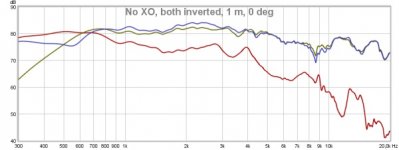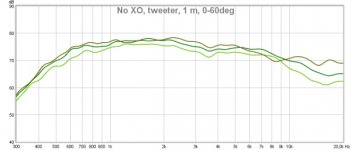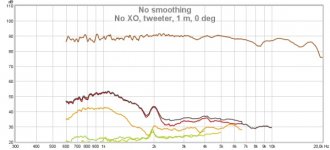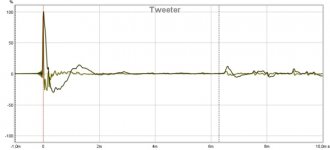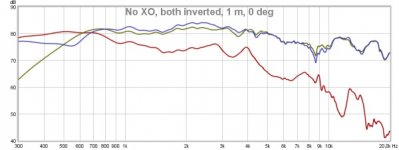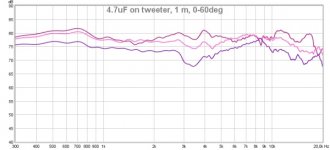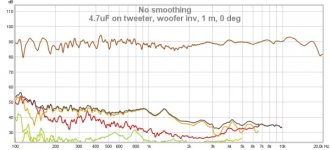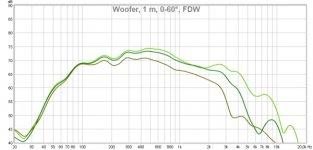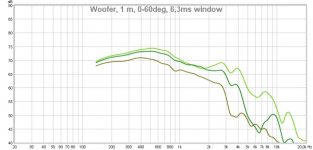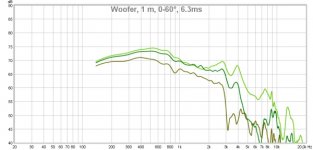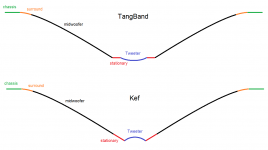Hi,
do you think could be possible to use the W8-2314 full range in a sealed box (Fc 80Hz) without any crossover on the woofer and a minimalist high pass crossover on the tweeter (starts from 3,5khz).
My idea is to use a natural sealed box's roll-off as mechanical high pass filter between woofer and a the subwoofer (seled) and the natural fullrange roll-off to be matched with the tweeter. Do you think that could be problems with the full range break up ?
Is there any way to build a mechanical low pass filter without use RLC components ?
Best
Greg
do you think could be possible to use the W8-2314 full range in a sealed box (Fc 80Hz) without any crossover on the woofer and a minimalist high pass crossover on the tweeter (starts from 3,5khz).
My idea is to use a natural sealed box's roll-off as mechanical high pass filter between woofer and a the subwoofer (seled) and the natural fullrange roll-off to be matched with the tweeter. Do you think that could be problems with the full range break up ?
Is there any way to build a mechanical low pass filter without use RLC components ?
Best
Greg
I'm referring to independent measurements and builds.
Well, considering this is a brand new driver and it just started selling a couple weeks ago, how many builds were you expecting?
Member
Joined 2009
Paid Member
Woofer measurements
Here are some measurements I've done. They are done indoors and windowed before first reflection (6.3 ms).
Here is the noise floor:
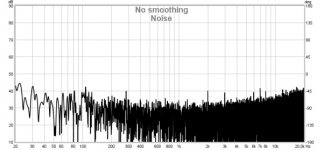
Here is response at 0, 30 and 60° at 30 cm distance:
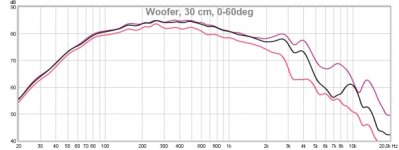
And at 1 m distance:
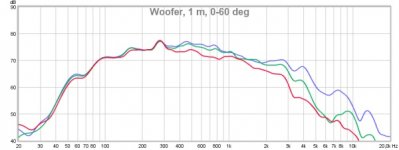
Here is distortion at 1 m, 0° and about 85 dB:
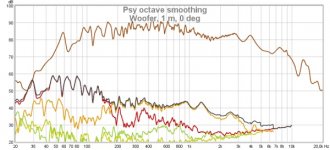
It's mounted in a 7.5 l box filled with denim. Baffle is 36 cm x 56 cm with chamfered edges. Mounted 24 cm from top and 18 cm from both edges.
/Anton
Here are some measurements I've done. They are done indoors and windowed before first reflection (6.3 ms).
Here is the noise floor:

Here is response at 0, 30 and 60° at 30 cm distance:

And at 1 m distance:

Here is distortion at 1 m, 0° and about 85 dB:

It's mounted in a 7.5 l box filled with denim. Baffle is 36 cm x 56 cm with chamfered edges. Mounted 24 cm from top and 18 cm from both edges.
/Anton
Attachments
More woofer measurements
Near field measurement (3 cm):
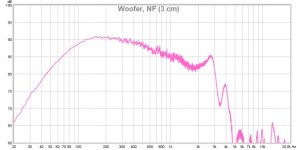
Impulse response at 1 m, 0°:
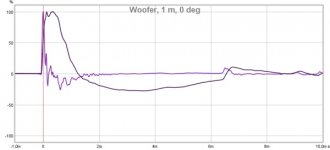
All distances have been measured from tweeter grill (metal). Driver is flush mounted. I have not measured impedance nor drive level. Microphone is miniDSP umik-1 (calibrated).
It's weird that the tweeter response differs so fundamentally from manufacturer curves... Especially above 4 kHz.
/Anton
Near field measurement (3 cm):

Impulse response at 1 m, 0°:

All distances have been measured from tweeter grill (metal). Driver is flush mounted. I have not measured impedance nor drive level. Microphone is miniDSP umik-1 (calibrated).
It's weird that the tweeter response differs so fundamentally from manufacturer curves... Especially above 4 kHz.
/Anton
Last edited:
Since the tweeter curves between the two drivers are identical and yet have different effective waveguide depths, I'm wondering if those curves are for flush-mounted tweeters on a flat baffle. Especially since the tweeter response seems to go much lower than seems apparent from the manufacturer curves. Just a thought.
Good point! Kind of misleading though...Since the tweeter curves between the two drivers are identical and yet have different effective waveguide depths, I'm wondering if those curves are for flush-mounted tweeters on a flat baffle. Especially since the tweeter response seems to go much lower than seems apparent from the manufacturer curves. Just a thought.
/Anton
Well, "kind of misleading" has long been the comments made on TB factory curves. If you can take measurements with a 2.83v drive, that should provide a more apples-to-apples comparison between your data and the factory data.
Thanks very much for the measurements.  Have you compared two units to see if they are consistent? I've had pretty good luck with TB drivers but know that friends have had units that varied widely.
Have you compared two units to see if they are consistent? I've had pretty good luck with TB drivers but know that friends have had units that varied widely.
 Have you compared two units to see if they are consistent? I've had pretty good luck with TB drivers but know that friends have had units that varied widely.
Have you compared two units to see if they are consistent? I've had pretty good luck with TB drivers but know that friends have had units that varied widely.Onni,
Is the x-over between tweeter and woofer built-in or do you have to design and install it yourself?
Is the x-over between tweeter and woofer built-in or do you have to design and install it yourself?
I only bought one...Thanks very much for the measurements.Have you compared two units to see if they are consistent? I've had pretty good luck with TB drivers but know that friends have had units that varied widely.
There is no built-in XO. I tested with a single cap as it was suggested in the thread. It works, but it's not very "flat". I tested two values.Onni,
Is the x-over between tweeter and woofer built-in or do you have to design and install it yourself?
Tweeter with cap:
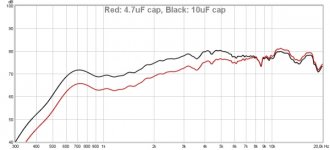
Together with woofer (inverted):
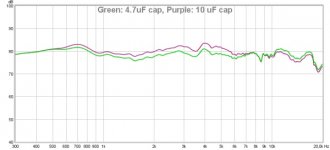
Distortion with only a 10uF cap:
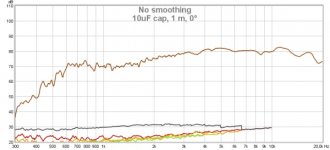
Not sure if the single cap is enough protection, but it seems so given the low distortion. But someone more capable will probably design both very simplistic and quite complicated crossovers that you can use.
/Anton
Near field measurement (3 cm):
View attachment 715135
Impulse response at 1 m, 0°:
View attachment 715136
All distances have been measured from tweeter grill (metal). Driver is flush mounted. I have not measured impedance nor drive level. Microphone is miniDSP umik-1 (calibrated).
It's weird that the tweeter response differs so fundamentally from manufacturer curves... Especially above 4 kHz.
/Anton
This is not weird. This is normal, considering it's TB. Measurements results are kind of dissappointing, especially tweeter off-axis performance with diffraction issues clearly visible around. Tweeter waveguided by midrange cone should have smooth and uniformly descending 30- and 60-degree curves. Price of this driver is not too low, they probably could optimize it a bit more.
- Home
- Loudspeakers
- Multi-Way
- TB new line of Coax drivers

